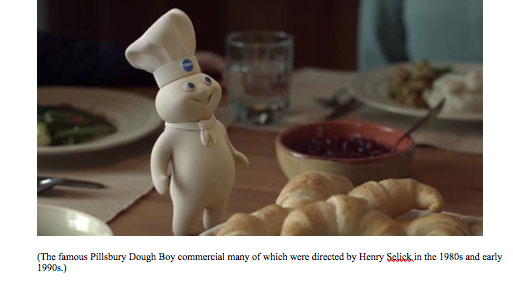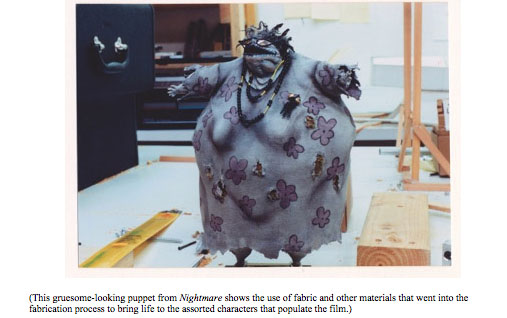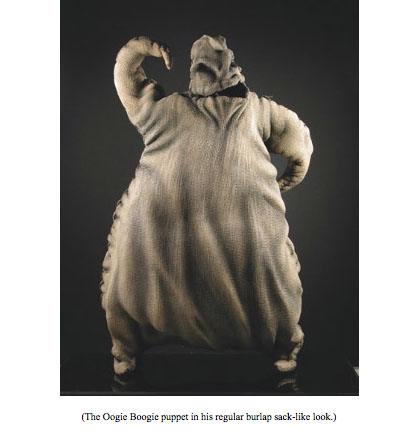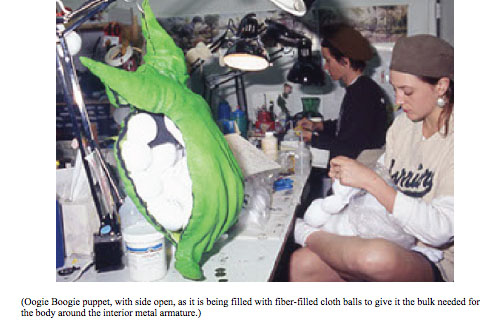
In Puppet Fabrication—Part 1, I wrote about the process that goes into the designing and planning behind the puppet fabrications for Tim Burton’s The Nightmare Before Christmas. I explained the rigorous process of getting the master sculptures of each character approved and ready for the next step. That review included the input from various department supervisors offering their critique, concerns, and suggestions, which are all considered before final approval. If a mistake or oversight happens at this stage, it could have costly and disruptive consequences during production.
Once the clay sculptures are approved, the fabrication process began. Mold maker supervisor John Reed and his team made molds of the finished sculptures and then cast a silicon master of each as a backup. With finished molds, the team was then able to start casting puppets out of liquid latex. This step required first carefully placing the finished metal armatures made of steel and aluminum into the mold and then injecting liquid latex foam around them. The precision of placement was necessary so that the different parts of the puppets would register properly from frame to frame. The molds were then baked for several hours so that the latex would harden to the desired consistency. Puppets with metal skeletons emerged ready for the next phase of preparation.

The character fabricator supervisor on the film was Bonita DeCarlo, who had gained experience in stop-motion working with Selick on fifty-two Pillsbury Doughboy spots and two Ritz Bits commercials at Colossal Pictures in the Bay Area. She and her team of skillfully trained artists and craftspeople handled the character-finishing process, including painting and adding costumes and accessories. DeCarlo is known for her innovative problem-solving and inventive solutions in the world of stop-motion animation. She created techniques on Nightmare that have since become industry standards.

Molds are generally made of two halves, but can have more pieces depending on the puppet’s complexity, which fit together tightly before the liquid latex foam is injected. Once the foam has set, the mold is pulled apart, and there is a seam of latex where the various parts of the mold join one another. That excess latex is referred to as flashing. Removal of the excess latex flashing was the first order of business. Lauren Vogt specialized in this procedure and patiently cleaned up and finished nearly all the film’s puppets, making them ready for wardrobe and makeup. The character’s face and body parts not covered by wardrobe were first prepped and then painted.

The paints required for the puppets were highly toxic, and the fabrication team was required to use the proper safety protection and precautions. They used a top-of-the-line spray booth, and respirators were necessary for any artist painting a puppet. “We used lacquers, urethane paints, fabric paints, acrylics; you name it, we probably used it,” said DeCarlo. One of the paints that was used is called SC-89. According to DeCarlo and the fabricators, “It is a wonderful paint” that provided flexible skin-on-foam latex. Still, it is also one of the most toxic paints available and thus necessitated extreme caution. This paint’s application required the use of a forced-air system, which consisted of a full-body suit with a face shield that had an attached hose that pumped in clean air, ensuring that the painter did not inhale any toxic fumes.
Along with the paints, the fabricating team used powders to give the puppets a more handcrafted graphic look. “The best powders available were from a theatrical makeup company that had every kind of eye shadow color available,” said DeCarlo. These powders all had matte finishes to them. The team did not use any powders with glitter to avoid lighting problems for the camera department.

“Jack’s costume consisted of a special flexible black fabric that was silk-screened with the white lines,” said DeCarlo. “Sally had a cloth fabric printed with the basic outline of the pattern and was then hand-painted with fabric paint.” Cloth fabric was used for other puppets like Lock, Shock, and Barrel, but most of the puppets were painted and then detailed with inks, fabric dyes, and powders. Costumes were then either painted directly on the latex shell or created out of separate pieces of foam. Sally’s multi-patterned dress was handmade with each element etched- or screened-on, one section at a time. This process is repeated for each character.
Jack’s entire head was replaced for each film frame in which he speaks or changes his expression. The animators followed an exposure sheet that was laid out in advance, indicating the mouth shape and expression needed on each film frame. An exposure sheet (x-sheet) is simply a road map to the shot, as previously explained. The animator uses the x-sheet to create and track each element: that is the puppet, mouth shape, expression, props, etc., in every frame of the shot.
Sally has a series of ten different facial designs that snap onto a frame. For each style or mood, there is a minimum of eleven distinct mouth positions. Each face was individually painted and repainted as necessary, based on repeated usage. The animation process itself requires the puppets to be continuously handled and positioned frame to frame, so the latex foam exterior wears out over time and is prone to damage. In Sally’s case, the outer layer was stripped off after every three or four shots, and the armature underneath it was recycled with new latex foam baked around it.

The Mayor of Halloween Town speaks and acts through a slightly different system of replacement parts. His head has two faces and rotates depending on his mood—happy or sad and worried. In his case, the eyeballs and mouth are detachable magnetic sections that can easily be exchanged to reflect the attitude and dialogue needed. The Mayor was designed so that there is a seam around his face that acts as the border between the replacement faces and the rest of his head. Thirteen different mouth positions for each face—the optimistic side and the pessimistic side—were needed to handle all the required dialogue.
During production, DeCarlo and her team set up what was dubbed the “puppet hospital.” It was an area of their department that allowed for quick repairs to puppets, continually being tugged and pulled into position frame by frame, enduring rough handling, which resulted in damage. They also had surprise situations that required fast alterations to the puppets. “Some of these required creating pajamas for the puppets, or Christmas-style accessories for the characters—just to name a few,” recalled DeCarlo. “I was very fortunate to have a wonderful team of very talented people working with me.”
Sometimes a character fell over due to a broken ankle on set, and the puppet needed to be repaired. It was sent to the puppet hospital to be fixed. This type of damage didn’t happen often. Still, when it did, the frame grabber (which allows the animator to see the current frame plus the two previous) came in handy because the puppet could be removed from the set, repaired, and then returned to the stage to be lined back up into position. Selick said that on long, complicated shots with multiple characters, “The puppet hospital and frame grabber were a huge godsend, in giving some relief to the stress that you didn’t have to start the shot over.”
The production team praised DeCarlo for the way she supervised the puppet fabrication team during production. “She’s a genius—the way she coordinated and supervised all of those people making foam costumes,” said Artistic Coordinator Allison Abbate, who later became a producer on Burton’s Corpse Bride and Frankenweenie. “The hair and makeup—it’s all of the things that you would think that a live performer would need, you would need to do for a puppet.”

One of the toughest and most challenging assignments facing DeCarlo and her fabrication department was creating the giant Oogie Boogie puppet. By far, this was the most massive puppet in the production, with an armature standing twenty-four inches tall. He was also required to look like a “potato sack.” According to DeCarlo, “This could be accomplished by using actual fabric, but that would have been unrealistic— fabric would not provide the flexibility necessary for the many shots and the agility needed for his performance.” The answer was to have a very detailed sculpt created, molded, and then cast in foam latex. Oogie Boogie, an imposing character, is one of the most enormous stop-motion puppets ever created.

Due to his size, the fabricators could not cast solid foam latex around the armature. Instead, a latex exterior “skin” was cast and then slipped down around the metal armature, which provided an open empty area around the armature. That open space was then packed with light fiber-filled cloth balls that provided the illusion of substance to the puppets’ bodies. Then the exterior was painted and prepped.
“It is an art form in and of itself just how to get the foam just right,” said Abbate. “The density had to be just right so that you could move the puppet, and it wouldn’t get too stiff.” It was all about making the foam the right consistency so that the armature would not get gummed up in the casting process.
An iridescent green version of the Oogie Boogie puppet was made for the ultraviolet song sequence, and a special gruesome bug-infested version was created for the unraveling of Oogie in the film’s finale. “[In] the final shot, when Oogie meets his demise, we needed to provide an interior puppet created entirely of insects,” said DeCarlo. The latter required the fabrication of nearly three thousand individual bugs, which included thirty different varieties—and all of them had to be moveable for animation. It was a very time-consuming process that yielded a stunning scene of animation.
For DeCarlo, a stop-motion veteran, her creations often take on a life of their own. “Each one has a distinct personality, and when we watch them in dailies, they seem very real to us.” Says DeCarlo, “One of the things that we’ve tried to do with this film is to push the limits as far as we possibly can, and that means creating some spectacular puppets unlike any that movie audiences have ever seen before.” When asked what the big challenge was in creating the film’s puppets, DeCarlo said, “Initially it was educating everyone not familiar with stop-motion about the time and budget demands of puppet fabrication. Luckily, I had the most amazing producer [Kathleen Gavin], who was very receptive and always gave me the opportunity to present my needs to fulfill the task at hand.”
Unlike traditional hand-drawn cel animation, the puppets are real objects brought to life, and that is what makes this technique so captivating. It is that notion of breathing life into an inanimate object that captured the imaginations of so many, including Burton, Selick, and the animators. “My personal favorite puppet was Jack as the Pumpkin King,” said DeCarlo. “It is the first time we see Jack in the movie. There was only one created, and I insisted on doing the fabrication myself. Unfortunately, right after the shot was accepted, the puppet was stripped down so we could use the armature for other Jack puppets. This means there isn’t a Pumpkin King puppet in the Disney’s archives.”

At the end of the production, many of the puppets, props, and even some of the sets were given away to the crew members because there was so much of it that it was impractical to store. Selick kept a sampling of character molds and sculpts, which in later years, Disney used to make new merchandise for the film’s fans as the popularity of the film grew year over year.
Today, the Nightmare puppets are coveted by those who were lucky enough to get one as a memento of working on the film. As I interviewed various team members for my book, it was a pleasure to see some of these puppets on display in homes and studios, being cared for like works of art — because they are. They are pliable sculptures that have a quality to them that makes you smile, to want to hold them, and have that tactile experience, that “feeling” the animators must have had daily while creating the animation for Nightmare.
Text ©2020 David Bossert
Portions of this article have been extracted from the author’s book, Tim Burton’s The Nightmare Before Christmas Visual Companion. All footnotes attributions are noted in the book.
“Dave Bossert has created a wonderful book to commemorate Tim Burton’s The Nightmare Before Christmas, more than twenty-five years on. He masterfully blends interviews with Tim Burton, Danny Elman, and myself—along with many of the talented artists who worked on the film—into a very nuanced and personal picture of how the movie actually came together, was made, and went from a cult favorite to a holiday classic. It’s a remarkable book about a remarkable, one-of-a-kind renegade project that has stood the test of time,” Henry Selick, Director, Tim Burton’s The Nightmare Before Christmas, said.


 David A. Bossert is an award-winning artist, filmmaker, and author. He received his B.A. from CalArts School of Film and Video with a major in Character Animation. As a 32-year veteran of The Walt Disney Company, he contributed his talents to The Black Cauldron (1985), Who Framed Roger Rabbit (1988), The Little Mermaid (1989), Beauty and the Beast (1991), Aladdin (1992), Tim Burton’s The Nightmare Before Christmas (1993), The Lion King (1995), Fantasia/2000 (1999), and the Academy Award-nominated shorts Runaway Brain (1995), Dali/Disney Destino (2003), and Lorenzo (2004), among many others. Bossert is now an independent producer, creative director, and writer.
David A. Bossert is an award-winning artist, filmmaker, and author. He received his B.A. from CalArts School of Film and Video with a major in Character Animation. As a 32-year veteran of The Walt Disney Company, he contributed his talents to The Black Cauldron (1985), Who Framed Roger Rabbit (1988), The Little Mermaid (1989), Beauty and the Beast (1991), Aladdin (1992), Tim Burton’s The Nightmare Before Christmas (1993), The Lion King (1995), Fantasia/2000 (1999), and the Academy Award-nominated shorts Runaway Brain (1995), Dali/Disney Destino (2003), and Lorenzo (2004), among many others. Bossert is now an independent producer, creative director, and writer.













































































A very painstaking, intricate procedure – and well worth it.
Imagine getting paid to do that.
Hello I am a artist trying to replicate the oogie boogie puppet, how was the face armature made? Like how did they get the movements in the face, what did they use as a face armature/structure
How did they make the armature for the face? How did they get those movement in the face to make those face expressions? What did they use as the armature for the face?